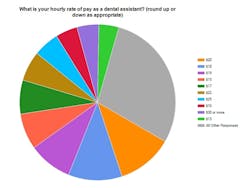Special day brings diabetes to attention of the world
By Maria Perno Goldie, RDH, MS
The International Diabetes Federation and the World Health Organization created World Diabetes Day in 1991 in response to the diabetes epidemic. Every year on November 14, World Diabetes Day brings diabetes to the attention of the world. November 14 is the birthday of Frederick Banting, one of the discoverers of insulin.
In 2006, the United Nations (UN) passed resolution 61/225. It asked the world to observe November 14 as World Diabetes Day and to take action to address the diabetes threat. The campaign evolved from one day in the year to a multi-year campaign, and the campaign has grown in strength from a modest one in its initial stages.
The call for action is Let’s Take Control of Diabetes. Now. In 2007, the World Diabetes Day logo incorporated the diabetes circle, a positive symbol across cultures, that symbolizes life and health. The color blue reflects the sky that unites all nations. The blue border of the circle reflects the color of the sky and the flag of the United Nations. The blue circle signifies the unity of the global diabetes community in response to the diabetes epidemic. (www.diabetesbluecircle.org)."Diabetes Education and Prevention" is the World Diabetes Day theme for the period 2009-2013. The campaign calls on all those responsible for diabetes care to understand diabetes and take control. Dental hygienists and dentists, and other oral health care providers, fall into this category. For people with diabetes, this is a message about empowerment through education. For governments, it is a call to implement effective strategies and policies for the prevention and management of diabetes to safeguard the health of their citizens with and at risk of diabetes. For health-care professionals, it is a call to improve knowledge so that evidence-based recommendations are put into practice. For the general public, it is a call to understand the serious impact of diabetes and know, where possible, how to avoid or delay diabetes and its complications. The key messages of the campaign are: Know the diabetes risks and know the warning signs; know how to respond to diabetes and who to turn to; and know how to manage diabetes and take control. The objectives for the 2009-2013 campaign were informed by the work of the Federation’s Consultative Section on Education and its Task Force on Epidemiology and Prevention. The objectives were further informed by the World Health Organization’s 2008-2013 Action Plan for the Global Strategy for the Prevention and Control of Noncommunicable Diseases (NCDs). This document is available online in English at www.who.int/nmh/en/. It explains that on September 19-20, 2011, the UN General Assembly convened a high-level meeting on NCDs. The four main NCDs are: cardiovascular disease, cancer, chronic lung diseases and diabetes. These diseases kill three in five people worldwide, and cause great socioeconomic harm within all countries, particularly developing nations. The decision by the UN General Assembly to convene a high-level meeting on NCDs this year presented a unique opportunity for the international community to take action against the epidemic, save millions of lives and enhance development initiatives. The World Dental Federation (FDI) spoke at the meeting on behalf of oral health, and oral diseases (dental caries and decay, and periodontal diseases) being chronic and associated with some of the diseases mentioned above. (www.who.int/nmh/events/un_ncd_summit2011/en/index.html). A fact sheet on oral health is available at www.who.int/mediacentre/factsheets/fs318/en/index.html.
Posters and other resources are available online.For a 111-page book entitled Get Inspired, visit the website. It is the World Diabetes Day Campaign Book with a Call to Action, activities, and resources.
Regarding periodontal inflammation and diabetes, it is a two-way relationship.Accessible scientific evidence on the effects of chronic periodontitis on diabetes mellitus is inadequate and inconclusive. This intervention study was designed to evaluate the effects of periodontal treatment on clinical response, systemic inflammatory parameters, and metabolic control in type 2 diabetes patients. (Chen L, Luo G, Xuan D, Wei B, Liu F, Li J, Zhang J. Effects of Non-surgical Periodontal Treatment on Clinical Response, Serum Inflammatory Parameters, and Metabolic Control in Type 2 Diabetic Patients: A Randomized Study. Journal of Periodontology, Posted online on 22 August 2011). At each visit, the primary efficacy measure (glycated hemoglobin, HbA1c) was determined, and secondary measures, including high-sensitivity C-reactive protein (hsCRP), fasting plasma glucose (FPG), triglycerides (TC), total cholesterol (TG), high-density lipoprotein cholesterol (HDL-C), low-density lipoprotein cholesterol (LDL-C), and tumor necrosis factor-alpha (TNF-α), were assessed by an independent and qualified commercial laboratory. Non-surgical periodontal treatment was shown to effectively improve periodontal and circulating inflammatory status. In this study, in association with significant improvements in periodontal measures, the hsCRP level declined markedly over time in both intervention groups, suggesting that non-surgical periodontal treatment contributed to improved systemic inflammatory status, which, in turn, helped to lower the risk for the development of microvascular complications in diabetic patients. Despite a lack of strong evidence, trends in some results support improved glycemic control after periodontal treatment in diabetic patients.Diabetes increases the risk of periodontal diseases, and biologically plausible mechanisms have been demonstrated in abundance. Less clear is the impact of periodontal diseases on glycemic control of diabetes and the mechanisms through which this occurs. Inflammatory periodontal diseases may increase insulin resistance in a way similar to obesity, thereby aggravating glycemic control. Further research is needed to clarify this aspect of the relationship between periodontal diseases and diabetes. (Mealey BL and Oates TW. AAP-Commissioned Review: Diabetes Mellitus and Periodontal Diseases. J Periodontol 2006; 77: 1289-1303. http://perio.org/resources-products/pdf/lr-diabetes.pdf)For information about Diabetes and Oral Health, visit the National Institute of Dental and Craniofacial Research (www.nidcr.nih.gov/OralHealth/Topics/Diabetes/). There are currently about sixteen clinical trials looking at the effects of periodontal therapy on systemic inflammation, glycemic control, and other markers. Others are looking at salivary proteins, different drugs, bone levels, quality of life, and other risk factors. An interdisciplinary primer focuses on diabetes-related conditions affecting the foot, eye, and mouth, as well as the issues related to drug therapy management. Working Together promotes a team approach to comprehensive diabetes care and provides simple care recommendations to clinicians about making cross-disciplinary treatment referrals. Its package includes Working Together Clinical Images and four prevention brochures targeted at specific medical disciplines. There is a dental brochure. (www.ndep.nih.gov/media/PPOD_Dental_Brochure.pdf). A recent study concluded that oral care providers should consider using a clinical guideline that includes the following predictors: waist circumference, age, self-reported oral health, self-reported weight and self-reported race or ethnicity, as well as any additional information on periodontal status and family history of diabetes. The clinical implications are that these clinical guidelines could help dentists and dental hygienists to identify patients with undiagnosed diabetes, resulting in the early identification of dental patients who require treatment for diabetes. This will most likely reduce morbidity and health care costs. (Li S, Williams PL and Douglass CW. Development of a Clinical Guideline to Predict Undiagnosed Diabetes in Dental Patients. JADA 2011;142(1):28-37.). Additional reading
JADA October 1, 2008; 139 (suppl 5) Mealey BL. The Interactions Between Physicians and Dentists in Managing the Care of Patients With Diabetes Mellitus. JADA October 1, 2008 139(suppl 5): 4S-7S. Kidambi S and Patel SB. Diabetes Mellitus: Considerations for Dentistry. JADA October 1, 2008 139(suppl 5): 8S-18S. Lamster IB, Lalla E, Borgnakke WS, and Taylor GW. The Relationship Between Oral Health and Diabetes Mellitus. JADA October 1, 2008 139(suppl 5): 19S-24S
JADA October 1, 2008; 139 (suppl 5) Mealey BL. The Interactions Between Physicians and Dentists in Managing the Care of Patients With Diabetes Mellitus. JADA October 1, 2008 139(suppl 5): 4S-7S. Kidambi S and Patel SB. Diabetes Mellitus: Considerations for Dentistry. JADA October 1, 2008 139(suppl 5): 8S-18S. Lamster IB, Lalla E, Borgnakke WS, and Taylor GW. The Relationship Between Oral Health and Diabetes Mellitus. JADA October 1, 2008 139(suppl 5): 19S-24S
Maria Perno Goldie, RDH, MS
To read previous articles in RDH eVillage FOCUS from 2011 written by Maria Perno Goldie, go to articles.








